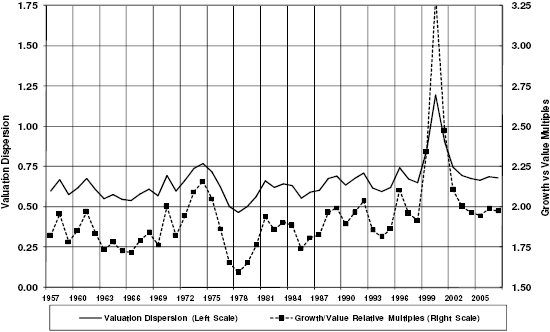Do equity investors systematically overpay for growth? In the September 2008 draft of their paper entitled “Clairvoyant Value and the Value Effect”, Robert Arnott, Feifei Li and Katrina Sherrerd compare the past prices of stocks with the discounted value of their actual subsequent cash flows (clairvoyant value) to measure the extent to which the market correctly anticipates firm growth. Using stock price and firm fundamentals data from the end of 1956 through the end of 2007 (51 years), they conclude that:
- Growth stocks (those trading at high multiples) do subsequently tend to exhibit superior growth.
- However, over the long run, investors have paid about twice the fair premium for growth stocks relative to value stocks.
- The average ratio of clairvoyant value-to-1956 stock price for smaller value (high book-to-market) stocks is nearly 20 times the average for larger growth stocks.
The following chart, taken from the paper, plots over the entire sample period two annual measures of the degree to which investors disagree on the relative merits of value stocks and growth stocks, valuation dispersion and the ratio of growth stock multiples to value stock multiples. These measures are at a minimum at year-end 1977 (after the “nifty fifty” bubble collapse) and a maximum at year-end 1999 (the apex of the tech bubble). The authors wonder, but do not test, whether a large (small) valuation dispersion indicates subsequent outperformance of value (growth) stocks.

In summary, retrospective analysis indicates that investors can identify growth stocks, but the long-term premium they pay for them is about twice that warranted by actual growth.